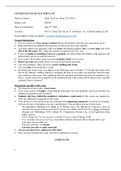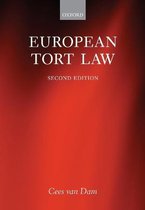COVER PAGE EXAM GLB TORT LAW
Name of subject : GLB: Tort Law (from 2017/2018)
Subject code : 620290
Date of examination : June 2nd, 2020
Lecturers : Prof. E. Tjong Tjin Tai; mr. F. Schemkes, Y.L. Garrido Gallego LL.M.
E-mail address of the coordinator: f.schemkes@tilburguniversity.edu.
General instructions
You are expected to show proper conduct during examinations and obey any instructions given.
Read and follow the additional instructions on Canvas for this exam carefully.
You must submit your questions with your name and Student number (Snr) on every page and in the
title of the file name! The 7-digit Snr number is printed on the TiU card.
If you are unable or unwilling to answer a question, you must submit the number of the question and
indicate that you can or will not answer it.
Firm action will be taken in the event that academic fraud is discovered.
Read every part thoroughly before you start answering the questions.
Use clear sentences. Take care to use correct spelling and syntax.
Use your time well and divide it evenly.
By taking part in this exam, you adhere to the following code of conduct: “I will take this exam to the
best of my abilities, without seeking or accepting the help of any source not explicitly allowed under
the conditions of the exam. Not complying with the statement invalidates the exam for summative use,
that is, a grade will not be assigned to your completed exam. Firm action will be taken in the event that
academic fraud is detected.”
Instructions specific to this exam
The duration of your exam is three hours.
Your exam consists of 6 pages, comprising the front page, two case problems, one essay question, the
additional assignment and an Annexe.
Students that have failed the mandatory attendance requirement of this course are required to
make the additional assignment on this exam.
Your answer to every question must be furnished with supporting arguments, involving, for example,
relevant sections of legislation, case law, and literature. You are allowed to use in this exam:
– the legislation contained in S. Hardy & N. Kornet (eds.), The Maastricht Collection: Selected
National, European and International Provisions from Public and Private Law, 6th ed., Groningen
(Europa Law Publishing) 2019, volume IV: Comparative Private Law, or the legislation from
online sources,
– T.F.E. Tjong Tjin Tai, Introduction to Global Tort Law, draft (Tilburg, 2019).
– C.C. van Dam, European Tort Law, 2nd edition, Oxford University Press: Oxford 2013, and
– your notes, lecture slides etc.
– You may reference via Oscola.
You may not refer to other materials.
You are not allowed to collaborate with others.
Once you have finished the exam, you need to upload it on Canvas.
GOOD LUCK!
1
, QUESTION 1 [50 points in total]
Yumfind is a publishing company that publishes reference works such as ratings of companies in various
sectors of the economy, collections of sports statistics and graphical representations of historical events. In
recent years it has expanded its presence online by offering an array of apps and web portals to utilise its
content library with modern technology.
Yumfind’s popular portal and app offer lists and ratings of local restaurants (similar to the well-known app
Tripadvisor). One day an investigative journalist discovers that Yumfind structurally has lower ratings for
Estonian restaurants, and does not take into account positive reviews for those restaurants. In his published
article, he states that the chairman of Yumfind went through an acrimonious divorce from his Estonian
(now ex-)wife. The chairman now wants nothing to do with Estonia, suggesting that this omission is
deliberate. Yumfind strongly denies this allegation, offers apologies and claims that the omission is due to
a programming error in the portal and a data conversion mistake. Yumfind quickly rectifies the mistake,
which indeed leads to higher ratings for those restaurants.
A group of Estonian restaurants in London wants to sue Yumfind for the mistake. They claim they have
lost turnover. They turn to you to advise them on the likelihood of success and the appropriate basis of their
claim.
Question 1.A (20 points, word limit 750 words)
Various torts might apply to the case, also depending on whether the allegation of the journalist turns out
to be true. For English law, focus your analysis only on the liability of Yumfind. You may assume that the
actions of the chairman are treated as actions of Yumfind.
Go over all the torts that have been discussed in this course, and for each tort:
- consider whether the facts of the case match the requirements of that tort (i.e. whether the tort is
applicable).
- If the facts do match the requirements of the tort, discuss whether the tort might successfully provide a
ground of liability for this case. Otherwise, if the facts do not match the requirements of the tort, briefly
explain why not.
You may discuss a group of torts (such as economic, property-related, personal torts) together instead of
discussing each tort within the group individually if you can explain with a general argument that such a
group is not applicable.
You only need to provide an analysis based on the materials of this course. It is possible that you cannot
give a definite answer on that basis (or given the facts). Insofar as you would need further research for a
definitive answer, you can point that out.
Question 1.B (15 points, word limit 500 words)
Now turning to German tort law: would a claim based on § 823 II BGB be successful under German tort
law? Again, focus only on the liability of Yumfind (which is also liable for the actions of the chairman). In
your answer, you must:
- list the conditions for liability under such a ground,
2






